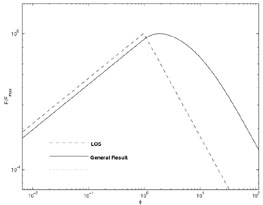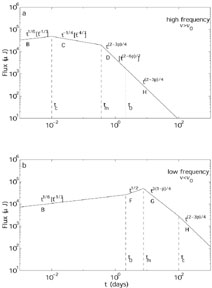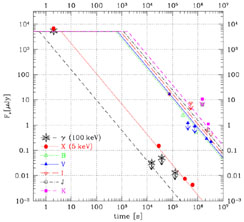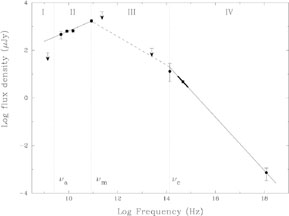


9.3. Synchrotron Emission from a Relativistic Decelerating Shell
We proceed now to estimate the expected instantaneous spectrum and
light curve from a relativistic decelerating shell. The task is fairly
simple at this stage as all the ground rules have been set in the
previous sections. We limit the discussion here to a spherical shock
propagating into a homogeneous external matter. We consider two
extreme limits for the hydrodynamic evolution: fully radiative and
fully adiabatic. If
 e is
somewhat less than unity during the fast cooling phase
(t < tfs) then only a fraction of the
shock energy is lost to radiation. The scalings will be intermediate
between the two limits of fully radiative and fully adiabatic
discussed here.
e is
somewhat less than unity during the fast cooling phase
(t < tfs) then only a fraction of the
shock energy is lost to radiation. The scalings will be intermediate
between the two limits of fully radiative and fully adiabatic
discussed here.
For simplicity we assume that all the observed radiation reaches the observer from the front of the shell and along the line of sight. Actually to obtain the observed spectrum we should integrate over the shell's profile and over different angles relative to the line of sight. A full calculation [259] of the integrated spectrum over a Blandford-McKee profile shows that that different radial points from which the radiation reaches the observers simultaneously conspire to have practically the same synchrotron frequency and therefore they emit the same spectrum. Hence the radial integration over a Blandford-McKee profile does not change the observed spectrum (note that this result differs from the calculation for a homogeneous shell [255]). On the other hand the contribution from angles away from the line of sight is important and it shapes the observed spectrum, the light curve and the shape of the Afterglow (see Fig 26).
 |
Figure 26. Calculated spectra or light
curve from a Blandford-McKee solution.
F |
The instantaneous synchrotron spectra from a relativistic shock were
described in section 8.2.4. They do
not depend on
the hydrodynamic evolution but rather on the instantaneous conditions
at the shock front, which determines the break energies
 c and
c and
 m. The only
assumption made is that the shock properties are fairly constant over a
time scale comparable to the observation time t.
m. The only
assumption made is that the shock properties are fairly constant over a
time scale comparable to the observation time t.
Using the adiabatic shell conditions (Eqs. 122-123), Eqs. 44 for the shock conditions, Eq. 56 for the synchrotron energy and Eq. 62 for the "cooling energy" we find:
 |
(132) |
where td is the time in days, D28 = D / 1028 cm and we have ignored cosmological redshift effects. Fig. 22 depicts the instantaneous spectrum in this case.
For a fully radiative evolution we find:
 |
(133) |
where we have scaled the initial Lorentz factor of the ejecta by a
factor of 100:
 100
100

 0
/ 100. These instantaneous
spectra are also shown in Fig. 22.
0
/ 100. These instantaneous
spectra are also shown in Fig. 22.
The light curves at a given frequency depend on the temporal
evolution of the break frequencies
 m and
m and
 c and the peak
power Ne Psyn(
c and the peak
power Ne Psyn( e,min) (see Eq. 66). These depend, in turn, on how
e,min) (see Eq. 66). These depend, in turn, on how
 and
Ne scale as a function of t.
and
Ne scale as a function of t.
The spectra presented in Fig. 22
show the positions of
 c and
c and
 m for typical
parameters. In both the adiabatic and radiative cases
m for typical
parameters. In both the adiabatic and radiative cases
 c decreases more
slowly with time than
c decreases more
slowly with time than
 m.
Therefore, at sufficiently early times we have
m.
Therefore, at sufficiently early times we have
 c <
c <
 m,
i.e. fast cooling. At late times we have
m,
i.e. fast cooling. At late times we have
 c >
c >
 m, i.e., slow
cooling. The transition between the two occurs when
m, i.e., slow
cooling. The transition between the two occurs when
 c =
c =
 m at
tfs (see Eq. 126). At t =
tfs, the spectrum changes from fast cooling
(Fig. 22a) to slow cooling
(Fig. 22b). In addition,
if
m at
tfs (see Eq. 126). At t =
tfs, the spectrum changes from fast cooling
(Fig. 22a) to slow cooling
(Fig. 22b). In addition,
if  e
e
 1, the hydrodynamical
evolution changes from radiative to adiabatic. However, if
1, the hydrodynamical
evolution changes from radiative to adiabatic. However, if
 e
<< 1, the evolution remains adiabatic throughout.
e
<< 1, the evolution remains adiabatic throughout.
Once we know how the break frequencies,
 c,
c,
 m, and the
peak flux
F
m, and the
peak flux
F , max vary
with time, we can calculate the light curve. Consider a fixed frequency
(e.g.
, max vary
with time, we can calculate the light curve. Consider a fixed frequency
(e.g.  = 1015
= 1015
 15 Hz).
From the first two equations in (132) and (133) we
see that there are two critical times, tc and
tm, when the break
frequencies,
15 Hz).
From the first two equations in (132) and (133) we
see that there are two critical times, tc and
tm, when the break
frequencies,  c
and
c
and  m, cross the
observed frequency
m, cross the
observed frequency  :
:
 |
(134) |
 |
(135) |
There are only two possible orderings of the three critical times,
tc, tm, tfs,
namely tfs > tm >
tc and tfs < tm
< tc. We define the critical frequency,
 0 =
0 =
 c(tfs) =
c(tfs) =
 m(tfs):
m(tfs):
 |
(136) |
When  >
>
 0, we have
tfs > tm >
tc and we refer to
the corresponding light curve as the high frequency light curve.
Similarly, when
0, we have
tfs > tm >
tc and we refer to
the corresponding light curve as the high frequency light curve.
Similarly, when  <
<
 0, we have
tfs < tm <
tc, and we obtain the low frequency light curve.
0, we have
tfs < tm <
tc, and we obtain the low frequency light curve.
Fig. 27a depicts a typical high frequency light
curve. At early times the electrons cool fast and
 <
<
 m and
m and
 <
<
 c. Ignoring self
absorption, the situation corresponds to segment
B in Fig. 22, and the flux varies as
F
c. Ignoring self
absorption, the situation corresponds to segment
B in Fig. 22, and the flux varies as
F ~
F
~
F , max(
, max( /
/
 c)1/3.
If the evolution is adiabatic,
F
c)1/3.
If the evolution is adiabatic,
F , max is
constant, and
F
, max is
constant, and
F ~
t1/6. In the radiative case,
F
~
t1/6. In the radiative case,
F , max ~
t-3/7 and
F
, max ~
t-3/7 and
F ~
t-1/3. The
scalings in the other segments, which correspond to C, D, H in
Fig. 22, can be derived in a
similar fashion and are shown in Fig. 27a.
~
t-1/3. The
scalings in the other segments, which correspond to C, D, H in
Fig. 22, can be derived in a
similar fashion and are shown in Fig. 27a.
 |
Figure 27. Light curve due to synchrotron
radiation from a spherical
relativistic shock, ignoring the effect of self-absorption. (a) The
highfrequency case ( |
Fig. 27b shows the low frequency light curve,
corresponding to  <
<
 0. In this case,
there are four phases in
the light curve, corresponding to segments B, F, G and H. The time
dependences of the flux are indicated on the plot for both the
adiabatic and the radiative cases.
0. In this case,
there are four phases in
the light curve, corresponding to segments B, F, G and H. The time
dependences of the flux are indicated on the plot for both the
adiabatic and the radiative cases.
For a relativistic electron distribution with a power distribution
 -p
the uppermost spectral part behaves like
-p
the uppermost spectral part behaves like
 -p/2. The
corresponding temporal index (for adiabatic
hydrodynamics) is -3p/4. In terms of the spectral index
-p/2. The
corresponding temporal index (for adiabatic
hydrodynamics) is -3p/4. In terms of the spectral index
 ,
this yields the relation
F
,
this yields the relation
F
 t(1-3
t(1-3 )/2.
Alternatively for slow cooling there is also another frequency range
(between
)/2.
Alternatively for slow cooling there is also another frequency range
(between  m and
m and
 c) for which the
spectrum is given by
c) for which the
spectrum is given by
 -(p-1)/2 and the
temporal decay is -3(p - 1) / 4. Now we have
F
-(p-1)/2 and the
temporal decay is -3(p - 1) / 4. Now we have
F
 t-3
t-3 /2.
Note that in both cases there is a
specific relation between the spectral index and the temporal index
which could be tested by observations.
/2.
Note that in both cases there is a
specific relation between the spectral index and the temporal index
which could be tested by observations.
9.3.2. Parameter Fitting for GRBs from Afterglow Observation and GRB970508
Shortly after the observation of GRB970228 Mészáros et al. [22] showed that the decline in the intensity in X-ray and several visual bands (from B to K) fit the afterglow model well (see fig. 28). The previous discussion indicates that this agreement shows that the high energy tail (or late time behavior) is produced by a synchrotron emission from a power law distribution.
 |
Figure 28. Decline in the afterglow of GRB970228 in different wavelength and theoretical model, from [22] |
There are much more data on the afterglow of GRB970508.
The light curves in the different optical bands generally peak
around two days. There is a rather steep rise before the peak which is
followed by a long power law decay (see
figs. 6,
7). In the optical band
the observed power law decay for GRB970508 is -1.141 ± 0.014
[151].
This implies for an adiabatic slow cooling model (which Mészáros
et al.
[22]
use) a spectral index
 = - 0.761 ±
0.009. However, the observed spectral index is
= - 0.761 ±
0.009. However, the observed spectral index is
 = - 1.12 ± 0.04
[260].
A fast cooling model,for
which the spectral index is p/2 and the temporal behavior is
3p/4 - 1/2, fits the data better as the temporal power law implies
that p = 2.188 ± 0.019 while the spectral index implies,
consistently, p = 2.24 ± 0.08
[246,
261] (see
Fig. 29).
Unfortunately, at present this fit does not
tell us much about the nature of the hydrodynamical processes and the
slowing down.
= - 1.12 ± 0.04
[260].
A fast cooling model,for
which the spectral index is p/2 and the temporal behavior is
3p/4 - 1/2, fits the data better as the temporal power law implies
that p = 2.188 ± 0.019 while the spectral index implies,
consistently, p = 2.24 ± 0.08
[246,
261] (see
Fig. 29).
Unfortunately, at present this fit does not
tell us much about the nature of the hydrodynamical processes and the
slowing down.
 |
Figure 29. The X-ray to radio spectrum of GRB 970508 on May 21.0 UT (12.1
days after the event). The fit to the low-frequency part,
|
Using both the optical and the radio data on can try to fit the whole spectrum and to obtain the unknown parameters that determine the fireball evolution [248, 249]. Wijers and Galama [248] have attempted to do so using the spectrum of GRB970508. They have obtained a reasonable set of parameters. However, more detailed analysis [249] reveals that the solution is very sensitive to assumptions made on how to fit the observational data to the theoretical curve. Moreover, the initial phase of the light curve of GRB970508 does not fit any of the theoretical curves. This suggests that at least initially an additional process might be taking place. Because of the inability to obtain a good fit for this initial phase there is a large uncertainty in the parameters obtained in this way.
No deviation in the observed decaying light curve from a single power
law was observed for GRB970508, until it faded below the level of
the surrounding nebula. This suggests that there was no
significant beaming in this case. If the outflow is in the form of
a jet the temporal behavior will change drastically when the opening
angle of the jet equals 1 /
 [258].
[258].